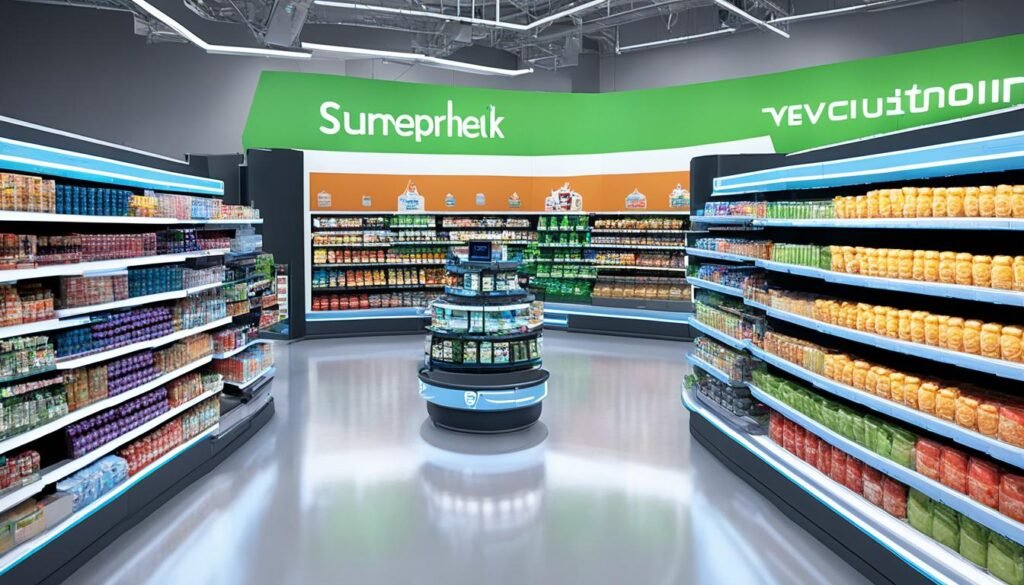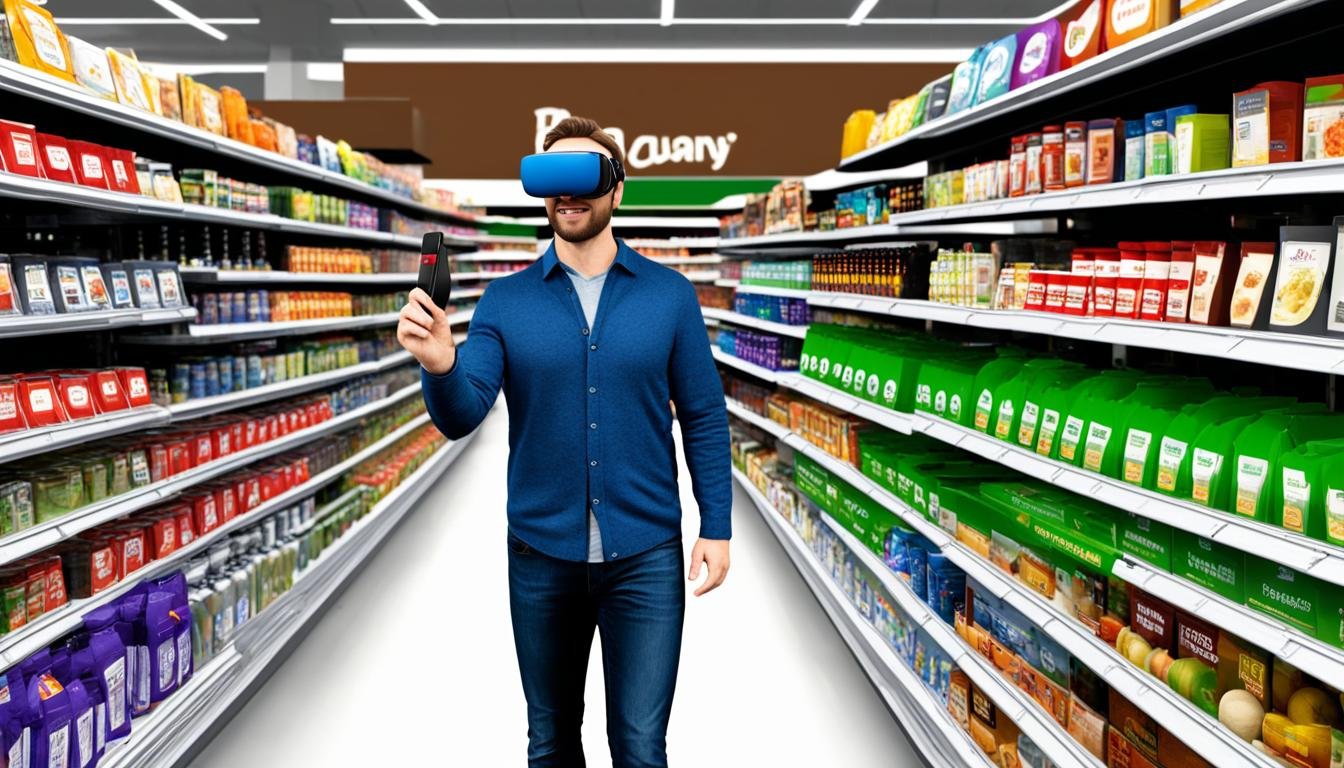The way we buy groceries changed a lot due to the COVID-19 pandemic. We now see an increase in shopping online for food. By June 2020, the online grocery market was worth $7.2 billion. This shows people are looking for more variety in products and making less visits to physical stores.
This change will make digital and immersive grocery shopping the new normal. Technologies like Virtual Reality (VR) and Augmented Reality (AR) are key. They make shopping better by letting us view products in different ways.
Retailers are working hard to make shopping fun and personal. They use simulator supermarket, virtual grocery store, and digital shopping experience tools. These change how we shop in our local stores.
We see new things like augmented reality supermarket setups, interactive grocery simulation, and 3D supermarket modeling. The future of buying groceries will be more like a game. And it will focus on putting products in front of us in smart ways.
Key Takeaways
- The COVID-19 pandemic has accelerated the shift towards digital and immersive grocery shopping experiences.
- Virtual Reality (VR) and Augmented Reality (AR) technologies are playing a crucial role in enhancing the grocery shopping experience.
- Businesses are exploring innovative ways to create more engaging and personalized shopping experiences through the integration of simulator supermarkets, virtual grocery stores, and digital shopping experiences.
- The future of grocery shopping is expected to become more gamified, with virtual product placement and smart retail simulation technologies driving the customer experience.
- Consumers are increasingly seeking diverse product selection and fewer physical trips to stores, making the digital and immersive shopping experience a key focus for businesses.
Transforming the Grocery Experience with Immersive Technologies
In recent years, the grocery industry has seen big changes. Virtual Reality (VR) and Augmented Reality (AR) are making shopping at local stores different. Since Facebook bought Oculus in 2014, these technologies have improved a lot. They’re not just for work meetings or making online shopping better but are also changing how we visit supermarkets.
The Rise of Virtual and Augmented Reality in Retail
The idea of a metaverse, a totally digital world, is making VR and AR more common for shopping. Now, people can try on clothes online or visit a virtual grocery store from home. This online trend in shopping grew during the COVID-19 pandemic. In April 2020, searches for things like “food delivery” and “grocery delivery” hit all-time highs on Google. This shows many people switched to online and virtual shopping then.
Enhancing the Customer Journey through Personalization
In grocery shopping, VR and AR can make the customer’s trip special and fun. Take, for instance, the game “Supermarket Shopping Simulator.” It sends players through different supermarkets, each with its own challenges. Players rush to find certain items before time runs out. This shows how VR and AR can make shopping not just interactive but also exciting.
| Technology | Application | Benefit |
|---|---|---|
| Virtual Reality (VR) | Fully immersive virtual grocery stores | Allows customers to shop and navigate through a 3D digital supermarket environment, enhancing the overall shopping experience |
| Augmented Reality (AR) | Overlaying digital information on the real-world supermarket | Enables customers to access additional product details, promotions, and personalized recommendations while shopping in the physical store |
| Gamified Simulation | Interactive grocery shopping experiences | Engages customers with challenges, time-based tasks, and a sense of exploration, making the shopping process more enjoyable and memorable |
How Does Virtual Grocery Shopping Work?
Grocery shopping is changing, all thanks to Virtual Reality (VR) and Augmented Reality (AR). These new techs make the supermarket experience futuristic. You can get a taste of it with simulator supermarket and virtual grocery store visits.
Exploring VR Grocery Experiences
With VR grocery shopping, all you need is a special headset. Then, you’re in a 3D world that feels like a real supermarket. You can walk around, look at products, and buy things just like in a store.
Augmenting Reality in the Supermarket Aisles
Besides VR, Augmented Reality (AR) is also making waves in groceries. People use their phones or similar devices with AR apps in the store. This lets them get extra info about items and see cool promotions, all in real-time in the aisles.
There are also fun grocery simulation games like “Supermarket Shopping Simulator.” They give you a taste of what 3D supermarket modeling and gamified shopping simulation are about, all at home. These games are not only fun but also show how virtual reality can help the grocery industry with virtual product placement and smart retail simulation.
Business Value of simulator supermarket and AR/VR Shopping
Today, the way we shop is changing fast. Thanks to virtual and augmented reality, there’s a new link between shopping online and in physical stores. Experts say using these new technologies can help stores and supermarkets a lot. They can make customers more interested, keep them coming back, and help stores understand their customers better.
Bridging the Gap Between Online and Offline Retail
Many people are starting to love virtual grocery shopping using HappyFresh’s “Happy Reality.” This shows how augmented reality in supermarkets can make it easy to move from online to real-life stores. With AR that knows where you are, stores can show you exactly where to find what you need. This makes shopping in person better and more personal for everyone.
Boosting Brand Loyalty and Customer Engagement
These new tech tools can make shoppers really feel connected to the products and brands they love. Imagine being able to see and play with products in ways you can’t in real life. It makes you more attached and loyal to those brands. This means people may keep buying from them and share their love for the brands with others.
Actionable Insights into Consumer Behavior
The information from virtual and augmented reality shopping gives stores useful details about what customers like and how they shop. With this data, stores can choose where to put products, what ads to show, and how much of each product they need. This helps stores run better and serve their customers more effectively.
Immersive Shopping: Use Cases and Innovative Applications
Retail is changing fast, using Virtual Reality (VR) and Augmented Reality (AR) to make shopping more exciting. Customers now get tailored product suggestions and AR maps to guide them through stores. This technology changes how we shop online and in virtual and real stores.
Personalized Shopping with Tailored Recommendations
Dent Reality shows how VR and AR can make shopping easier. It lets users make lists and find products easily in stores. Then, it suggests items based on what they like or recipes they pick. This makes shopping more personal and convenient.
Location-Based AR for Virtual Grocery Stores
In China, an e-commerce company uses AR to make finding products in virtual stores easy. The app helps users navigate by showing product locations. This use of AR simplifies shopping, making the experience better for shoppers.
These examples prove VR and AR are big in changing how we grocery shop. With features like personalized advice and AR maps, shopping gets more fun. These tools mix gamification and simulations to keep customers interested and loyal.
Challenges Facing Widespread AR/VR Adoption in Retail
Virtual Reality (VR) and Augmented Reality (AR) can really help retailers and grocery stores. But, they face some hurdles to be used everywhere. These hurdles span from high costs to user experience problems.
Cost and Budgetary Considerations
The initial cost of setting up VR or AR in a store is a main issue. Many businesses can’t invest big amounts into these new technologies. Also, customers need special equipment, like VR headsets, to use these features. This further adds to the cost.
Overcoming Technology Limitations and User Experience Barriers
Challenges also exist in making sure the tech actually works for everyone. Some people might not like using VR or AR in a retail setting. They prefer the simplicity of real-world shopping. Plus, the tech might not always be reliable, impacting the overall experience for users.
As technology advances and people get more used to these digital experiences, these roadblocks could disappear. This change would empower more stores to use virtual reality for better shopping experiences.
The Future of Immersive simulator supermarket Experiences
Grocery shopping is already getting more digital and immersive. Virtual Reality (VR) and Augmented Reality (AR) are key. They’re changing how we shop, making it more tech-focused and creative.
Advancements in Hardware and Software
Immersive shopping tech is getting better, lighter, and simpler to use. Soon, we’ll shop in amazing virtual worlds. This means detailed images that make shopping virtually feel real.
Integration of AI and Machine Learning
Artificial Intelligence (AI) and Machine Learning (ML) will power interactive shopping. They bring custom suggestions and smarter shopping paths. Shoppers will get virtual product displays that match their tastes exactly.

Leveraging simulator supermarket for Competitive Advantage
The grocery industry is changing fast. Businesses that use virtual grocery store and augmented reality supermarket tech are getting ahead. They’re adding interactive grocery simulation and gamified shopping simulation tools. This move boosts loyalty and keeps customers coming back. It also gives them smart data-driven insights for better decisions.
Enhancing Customer Loyalty and Retention
Today, simulator supermarket and 3D supermarket modeling are making shopping more fun. This tech makes customers feel more connected to the brand. Through a digital shopping experience set in an immersive retail environment, brands are sticking in customers’ minds. They’re coming back and telling friends. This boosts a company’s long-term success.
Data-Driven Insights for Strategic Decision-Making
Interactive grocery simulation and smart retail simulation platforms are not just for fun. They collect tons of data that businesses can use. With these data-driven insights, retailers can place products better. They make ads that customers love and manage stock smarter. This helps them meet the changing needs of their shoppers in the virtual grocery store.
| Key Benefits of Integrating simulator supermarket Technology | Metrics |
|---|---|
| Enhanced Customer Loyalty and Retention | Increased repeat purchases, higher customer lifetime value, improved Net Promoter Score |
| Personalized Shopping Experiences | Increased engagement, higher conversion rates, improved customer satisfaction |
| Actionable Insights into Consumer Behavior | Optimized product placements, improved targeted advertising, more efficient inventory management |
| Competitive Advantage in the Grocery Market | Increased market share, higher profitability, improved brand reputation |
Getting Started with Virtual Grocery Shopping Solutions
As virtual experiences grow in the retail and grocery worlds, picking the right tech partners is crucial. They need to look for companies skilled in making virtual supermarkets and augmented reality. This helps them smoothly add new tech for better digital and interactive shopping.
Evaluating Technology Partners and Solution Providers
Businesses should check out what potential partners can do. They need to see if they’re good at creating 3D models of supermarkets and fun shopping games. It’s important they understand how to make shopping in virtual stores an exciting experience for customers. Working with top tech developers helps add smart shopping to their stores and improve the way customers shop.
Developing an Immersive Shopping Strategy
Besides finding the right tech partners, companies also must plan how to make their shopping experience stand out. They should think about how to make virtual grocery stores user-friendly and match their brand. A good plan ensures that using new tech brings real benefits, like more loyal customers, better data, and a stronger place in the market.
Conclusion
Virtual Reality (VR) and Augmented Reality (AR) are changing how we shop for groceries. They help businesses engage customers more, improve brand loyalty, and understand buying habits better. Though there are challenges like cost and tech limitations, the future of grocery shopping will be digital and exciting.
Bussinesses can use these techs to make shopping special and stand out. Imagine getting personalized recommendations or seeing virtual grocery stores in your area through AR. The possibilities with VR and AR in retail and groceries are huge and growing fast.
As more businesses use virtual experiences, it’s key to pick the right tech partners and have solid plans. Staying innovative is crucial to benefit from these changing technologies. With a focus on digital and immersive shopping, companies can keep customers happy, improve how they work, and lead in the competitive retail world.
FAQ
How have Virtual Reality (VR) and Augmented Reality (AR) technologies impacted the grocery shopping experience?
The COVID-19 pandemic pushed people to look for digital solutions in shopping. In April 2020, searches for “food delivery” and “grocery delivery” hit a record high on Google. By June, online grocery shopping was valued at .2 billion. This shows a big change in how people shop. The use of VR and AR tech makes the future of grocery shopping all about digital and immersive experiences.
How do VR and AR technologies work in the context of grocery shopping?
With VR, users put on a headset and enter a virtual supermarket. They can wander around and choose items as if they were really there. For AR, users see their real surroundings with digital overlays. This might include information about products when scanned with an AR app.
What are the key business value propositions of using VR and AR technologies in grocery shopping?
VR and AR can help stores and retailers in a lot of ways. They can make shopping more personal and bridge the gap between online and offline. These technologies can also make people more loyal to brands and add value to products. Furthermore, they provide valuable data about how customers shop.
Can you provide examples of how VR and AR technologies are being used to enhance the grocery shopping experience?
There are already cool examples out there. For instance, a Chinese e-commerce site uses AR to help customers spot products in-store. HappyFresh gives a virtual shopping experience with Happy Reality. Then, there’s the Dent Reality app that lets users make shopping lists. It shows them where to find the products in the store with AR.
What are some of the challenges hindering the widespread adoption of VR and AR technologies in the grocery sector?
The cost of making and using these technologies is a big challenge. Creating VR and AR experiences can be expensive. Not everyone has the devices, like VR headsets, to try these apps. Some people just prefer shopping without digital help. Also, current technology might not offer a perfect shopping experience.
What is the future outlook for immersive grocery shopping experiences?
The future of shopping is getting more digital and fun. VR and AR will play bigger roles. We might start doing even everyday shopping with virtual help. The devices we use are getting better too. They will be lighter and offer sharper images. AI could also join in, making the shopping experience even better.
How can businesses leverage VR and AR technologies to gain a competitive advantage in the grocery market?
Businesses can use VR and AR to keep customers loyal and understand their needs better. These technologies let companies offer shopping experiences that stand out. They can learn a lot about how people shop. This info is key for making smart choices on where to put products and what ads to show.








